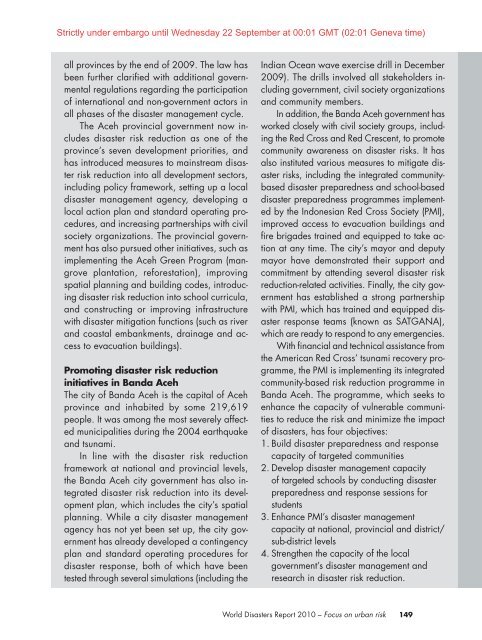chapter 4 - DRK
chapter 4 - DRK
chapter 4 - DRK
Create successful ePaper yourself
Turn your PDF publications into a flip-book with our unique Google optimized e-Paper software.
Strictly under embargo until Wednesday 22 September at 00:01 GMT (02:01 Geneva time)all provinces by the end of 2009. The law hasbeen further clarified with additional governmentalregulations regarding the participationof international and non-government actors inall phases of the disaster management cycle.The Aceh provincial government now includesdisaster risk reduction as one of theprovince’s seven development priorities, andhas introduced measures to mainstream disasterrisk reduction into all development sectors,including policy framework, setting up a localdisaster management agency, developing alocal action plan and standard operating procedures,and increasing partnerships with civilsociety organizations. The provincial governmenthas also pursued other initiatives, such asimplementing the Aceh Green Program (mangroveplantation, reforestation), improvingspatial planning and building codes, introducingdisaster risk reduction into school curricula,and constructing or improving infrastructurewith disaster mitigation functions (such as riverand coastal embankments, drainage and accessto evacuation buildings).Promoting disaster risk reductioninitiatives in Banda AcehThe city of Banda Aceh is the capital of Acehprovince and inhabited by some 219,619people. It was among the most severely affectedmunicipalities during the 2004 earthquakeand tsunami.In line with the disaster risk reductionframework at national and provincial levels,the Banda Aceh city government has also integrateddisaster risk reduction into its developmentplan, which includes the city’s spatialplanning. While a city disaster managementagency has not yet been set up, the city governmenthas already developed a contingencyplan and standard operating procedures fordisaster response, both of which have beentested through several simulations (including theIndian Ocean wave exercise drill in December2009). The drills involved all stakeholders includinggovernment, civil society organizationsand community members.In addition, the Banda Aceh government hasworked closely with civil society groups, includingthe Red Cross and Red Crescent, to promotecommunity awareness on disaster risks. It hasalso instituted various measures to mitigate disasterrisks, including the integrated communitybaseddisaster preparedness and school-baseddisaster preparedness programmes implementedby the Indonesian Red Cross Society (PMI),improved access to evacuation buildings andfire brigades trained and equipped to take actionat any time. The city’s mayor and deputymayor have demonstrated their support andcommitment by attending several disaster riskreduction-related activities. Finally, the city governmenthas established a strong partnershipwith PMI, which has trained and equipped disasterresponse teams (known as SATGANA),which are ready to respond to any emergencies.With financial and technical assistance fromthe American Red Cross’ tsunami recovery programme,the PMI is implementing its integratedcommunity-based risk reduction programme inBanda Aceh. The programme, which seeks toenhance the capacity of vulnerable communitiesto reduce the risk and minimize the impactof disasters, has four objectives:1. Build disaster preparedness and responsecapacity of targeted communities2. Develop disaster management capacityof targeted schools by conducting disasterpreparedness and response sessions forstudents3. Enhance PMI’s disaster managementcapacity at national, provincial and district/sub-district levels4. Strengthen the capacity of the localgovernment’s disaster management andresearch in disaster risk reduction.World Disasters Report 2010 – Focus on urban risk149
















